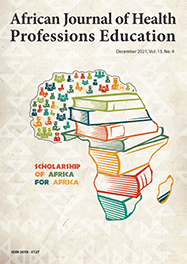Articles

Assessment of the education environment of senior medical students at the University of the Free State, Bloemfontein, South Africa
Abstract
Background. The education environment (EE) of a medical school plays a critical role in the learning of its students. The learner, other learners, teachers and the physical environment (campus and hospitals) influence the EE. In addition to recommendations of the Health Professions Council of South Africa (HPCSA) to revise the clinical training platform, staff and senior medical students occasionally experienced the EE in the clinical departments to be challenging.
Objective. To assess the perceived EE in clinical departments at the University of the Free State, Bloemfontein, South Africa, among the 2012 fourth- and fifth-year medical students. Differences in perceived EE scores between different demographic groups were also assessed.
Method. Only the departments where students rotated in both their fourth and fifth years (Obstetrics and Gynaecology, General Surgery, Paediatrics and Neonatology, Internal Medicine, and Psychiatry) were assessed. The Dundee Ready Education Environment Measure (DREEM) questionnaire was contextualised for each department and distributed among fourth- and fifth-year medical students. Questionnaires were self-administered and participation was voluntary. Differences among demographic groups and departments were assessed using the Mann-Whitney U-test and Kruskal-Wallis test (p<0.05).
Results. The overall response rate was 87.7%. The overall median DREEM combined score for the departments was 137/200. Paediatrics and Neonatology was consistently top-rated, whereas Obstetrics and Gynaecology consistently received the lowest rating in all domains and subscale analyses. There were few significant differences between the DREEM scores of demographic groups.
Conclusion. The overall EE in the clinical departments was mostly positive, although concerns were raised regarding some departments.
Authors' affiliations
Scarpa Schoeman, Department of Internal Medicine, Medical Education Division, School of Medicine, Faculty of Health Sciences, University of the Free State, Bloemfontein, South Africa
Raphuting Raphuting, School of Medicine, Faculty of Health Sciences, University of the Free State, Bloemfontein, South Africa
Sebakeng Phate, School of Medicine, Faculty of Health Sciences, University of the Free State, Bloemfontein, South Africa
Lefokase Khasoane, School of Medicine, Faculty of Health Sciences, University of the Free State, Bloemfontein, South Africa
Cecilia Ntsere, School of Medicine, Faculty of Health Sciences, University of the Free State, Bloemfontein, South Africa
Full Text
Keywords
Cite this article
Article History
Date published: 2014-11-03
Article Views
Full text views: 3363




.jpg)
Comments on this article
*Read our policy for posting comments here